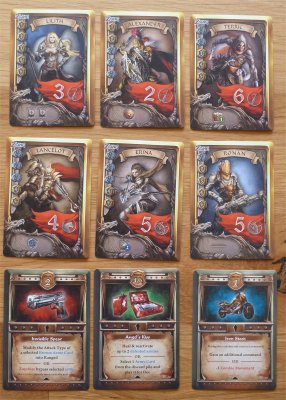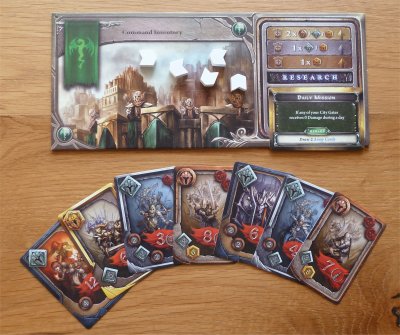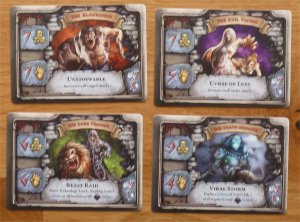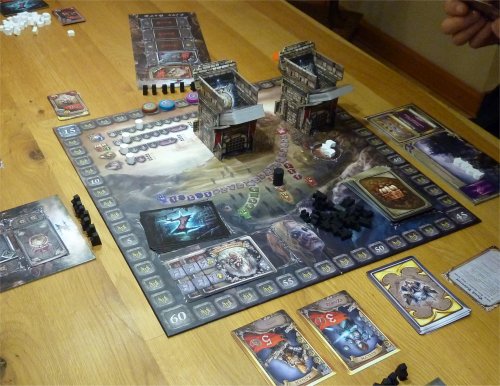

![[IMAGE]](../bilder/daz1.jpg) |
Designer: Publisher: No. of Players: |
![[IMAGE]](../technik/box/rot/rot-6.gif) ![[IMAGE]](../technik/box/gelb/gelb-10.gif) ![[IMAGE]](../technik/box/grun/grun-7.gif) ![[IMAGE]](../technik/box/pink/pink-9.gif) ![[IMAGE]](../technik/box/blau/blau-8.gif) |
|
The main factor which has initially attracted me to this Kickstarter project was the somewhat unusual setting. Of course, we have seen a wagonload of Zombie games in the last few years, but the setting of Dark Age Z is unique in so far as the players take the roles of medieval lords who are faced with a horde of modern age Zombies coming through a time rift. So, on the one hand we have Heroes, Knights and Archers fighting at the frontiers of each player's kingdom, but on the other hand you have guns, motorcycles and quite a few other modern age gadgets which the Zombies are dragging along through the rift. Ever since the Back to the Future movies I have been fond of time travelling stories, and seeing the somewhat uncommon illustrations of this boardgame project my interest was kindled.
As indicated, the Zombies are the common threat to all players in Dark Age Z, but before the game starts the players have the possibility to decide whether they want to play a fully cooperative or a competitive game. Both game modes differ in so far as the competitive game sees each player fighting for himself to score most victory points, whereas the cooperative game challenges the players to reach a certain threshold with their combined scores. However, these game modes also differ concerning player tactics, since the setup of the game gives the players some possibilities for direct interaction - either positive or negative. Each player has his own kingdom board in front of himself, and he will have to fight against the Zombies on two frontiers. The players share one frontier each with their left and right neighbors, and so there will be no lonely empire building, but instead everybody will keep watching what his neighbors will be doing at the frontiers.

However, apart from the fact that the players only have a limited number of army cards at their hand, there is quite a number of considerations which can influence the decision on when and where to place an army card. Most importantly, all player actions effectively cost time or command resources, and as can be expected the time and resources to prepare for a round's Zombie invasion always seems to be too short and too few. The players have to use actions to draw new army cards, gather useful modern age artifacts (which offer one-use benefits), play and reactivate army cards and upgrade their technology levels. These actions are taken by the players one at a time at the panning phase of each round, and most actions will trigger a step of the pitiless Zombie timer which denotes the end of preparations and the beginning of this round's attacks. However, there is also an incentive to finish actions early, since each player who declares that he will pass is allowed to choose a Hero card from a common array of Heroes which has been revealed at the beginning of the round. Not only will these Heroes offer additional strength on the battlefields, but they also possess certain unique skills which may allow the players to gain Victory Points, an artifact etc.  When it comes to placing army cards at a frontier, there is quite a range of considerations which the players are faced with. A new army card always is put in the first free slot facing towards the Zombies, and when the Zombie attack begins the horde will fight one slot after the other. If an army defats some Zombies, its owner will score victory points, but if the Zombie horde is too big the army also will be defeated and is possibly lost. So, the position of an army at a frontier is quite important, and naturally the players try to kill as many Zombies as possible without losing their rare, high ranking army cards. Depending on a player's technology level, players also may opt to reinforce already placed army cards by additional cards, and so the timing for each player action is rather important to lure the other player sharing the same frontier into playing army cards which may not come to bear. Through the use of Archers there is even a possibility for army cards from two slots to combine their strengths, and this actually entitles the owner of the Archer army card to claim the first defeated Zombie as a trophy for his assistance.  The situation gets especially nasty if all five army card slots on a frontier are occupied. In this situation a player is still allowed to play an army card onto this frontier, but the new card will force all other army cards to move a step forwards, resulting in the zombification of the front rank army. Such a move may significantly change both the battle outcome of a frontier and the victory point calculations, and so it is a nasty but efficient way to hamper the plans of your neighbor. Talking about plans, each player also has his own secret mission card which he has chosen at the beginning of the game. The players can chose between in-game benefits and an end-game scoring bonus, and so each player will follow a slightly different agenda during the course of the game.  Unlike many of the colourful, easy-going Zombie-slaying boardgames, Dark Age Z offers a rather dark atmosphere and a tactically challenging playing mechanism. No dice rolling, no fantastic weaponry - the mere survival of the of the players' kingdoms constantly requires the players to calculate and re-evaluate the possible battle results at both of their frontiers. Apart from these calculations the players have to decide which actions they should execute, but due to the restricted time available for player actions the game does not turn into an endless arithmetic monster. Furthermore, despite the fact that the Zombie battles are somewhat repetitive, the flow of the game (four normal rounds plus the Round 5 Zombie Boss attack) offers enough variety to keep the game entertaining and interesting. With these attributes the game qualifies as a rather positive debut for both Anakin and SMOOTHIE GAMES, and due to the unusual playing mechanism and the atmospheric artwork Dark Age Z certainly is a quite remarkable representative of the genre. | ||
|
| ||

|
|

|
|
| ||
|
Impressum / Contact Info / Disclaimer Kulkmann@aol.com
Copyright & copy; 2015 Frank Schulte-Kulkmann, Essen, Germany | ||